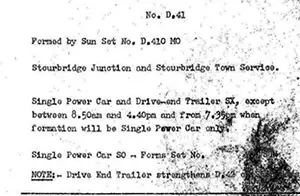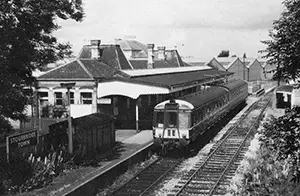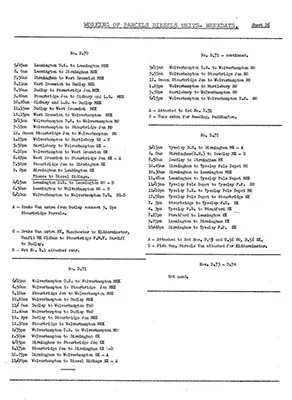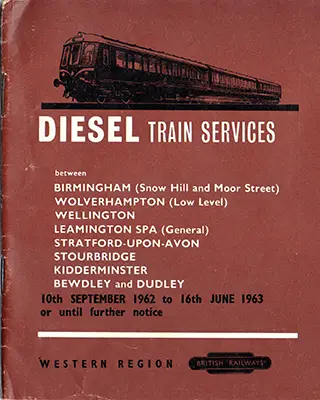Passenger and Parcels workings on the Stourbridge Line in 1963 — opportunity missed?
By Andrew Cope, written in August 2023 for the Stourbridge Line User Group as part of capturing the history of that line.
Today’s railway is a pretty homogeneous affair and runs to a regular pattern. In the case of services for the Stourbridge Line sets are stabled at Worcester and Tyseley with the addition of a couple of Chiltern sets at Stourbridge-all quite straightforward really. It’s not always been so quite straightforward though, in the early 1960s when the railway was still very diverse the operation was extremely complex.
I have always had an interest in the timetabling and workings of passenger services on the railway. Recently I was lucky enough to have access to a set of June 1963 carriage and Diesel Unit (or DMU as they were termed) workings for the Birmingham area. Most of these documents have long since been put in the bin as they were regularly updated every few months which meant it was best to destroy the previous copy lest it lead to confusion so to get to look through a complete set of these is extremely unusual. What I found particularly interesting were some of the workings which could not be imagined today. So, this article delves into a rare surviving carriage working document and shows the diversity of operation in those now far off days showing what once was and sadly, in most cases, will not ever be possible again.
I have concentrated mainly on Monday to Friday workings but have also highlighted one or two interesting weekend workings. The term “diagram” in the context of this article and used quite a lot is railway terminology for a days working of a Diesel Unit (DMU) or a set of coaches. Extensive use seems to have been made of the ability to join diesel sets together and many workings contain more than one Diesel Unit (DMU). However, it wasn’t quite so easy to join and split sets in those days as a person (a shunter) was required to physically get down and couple or uncouple units unlike today where the operation can be performed from the drivers cab.
By 1963 most passenger workings on the Stourbridge line had gone over to diesel units. Despite this there were a few steam workings still in existence and I have covered these. It seems that under the modernisation plan “Diesel Sidings” were identified at key locations, designated “D.S” in official publications, which on our line were at Worcester, Kidderminster and Stourbridge. The “Diesel Sidings” at Kidderminster were just to the south of the Worcester bound platform but I am unsure exactly where the “Diesel Sidings” were at Stourbridge. Possibly they were where the fuelling point was at Stourbridge Shed or maybe where the car park is by the old platform 4 at the Junction-more likely to be the former.
At the period of time we are looking at there were a number of Diesel Units operating through Stourbridge on the Cardiff to Birmingham route which were operated by the very comfortable well appointed “Cross Country” diesel Multiple Units, which for a short while 1959-1962, included a buffet service. By 1963 the buffet car remained but its use had been discontinued so ran with the counter area locked up. I haven’t included details of the Cardiff to Birmingham workings as these trains were almost exclusively Cardiff Canton allocated and based units although regularly worked by Stourbridge train crew. These particular trains were not stabled or serviced on our line other than some going to Tyseley overnight for servicing. Tyseley also had a small allocation of these “Cross Country” units of its own at this time but mostly these worked Leamington, Stratford, Evesham Worcester services with the exception of 0900 “Saturdays Only” Stourbridge to Oxford service which was formed of one of Tyseley’s Cross Country sets strengthened with a Tyseley Suburban set.
Workings off Stourbridge
These tables show the Monday to Friday workings off Stourbridge Diesel Sidings and loco hauled (steam) workings.
Diesel sets
| Diag Number | Unit Type | Working off shed | Ends day at | Remarks or first working |
|---|---|---|---|---|
| D35 | 3 Car Suburban (Class 116) | 0440 to Kidderminster | Leamington | With D43 and D44 attached at rear. D43 and D44 detached at Kidderminster then 0510 Kidderminster to Arley empty for 0545 Arley to Snow Hill |
| D36 | 3 Car Suburban (Class 116) | 0505 to Junction | Stourbridge | 0515 SJ-Snow Hill |
| D37 | 3 Car Suburban (Class 116) | 0535 to Junction | Stourbridge | 0545SJ-Snow Hill |
| D38 | 3 Car Suburban (Class 116) | 0605 to Junction | Leamington | 0615SJ-Snow Hill |
| D39 | 3 Car Suburban (Class 116) | 0620 to Junction | Stourbridge | 0635 SJ-Bewdley |
| D41 | Single “Bubble” car with Drive End Trailer (Class 122) | Town Motor service | Stourbridge | |
| D42 | Single “Bubble” car with Drive End Trailer (Class 122) | 0550 empty to Dudley | Stourbridge | 0620 Dudley-Old Hill |
| D43 | Single “Bubble” car with Drive End Trailer (Class 122) | 0440 empty to Kidderminster | Stourbridge | With D35 and D44 to Kidderminster then detached for 0525 Kid to Arley Empty and 0630 Arley to Hartlebury |
| D44 | 3 Car Suburban (Class 116) | 0440 empty to Kidderminster | Stratford | Detached from D35 and D43 at Kidderminster forms 0542 Kidderminster to Snow Hill |
Loco hauled sets
| Diagram No | Description | Mon-Fri | Ends day at | Remarks |
|---|---|---|---|---|
| 153 Loco hauled | A six car set formed of three second Corridor plus two Brake Corridor plus one Composite Corridor | 0715 Stourbridge to Snow Hill and 1741 back from Snow Hill Mon-Friday | Stourbridge (Eastbourne on Saturdays) | On Saturdays this set went empty coupled to 170 set to Snow Hill from Stourbridge at 0920 and formed the Eastbourne portion of 1030 Snow Hill Eastbourne/Hastings returning the following Saturday at 1240 from Eastbourne |
| 170 Loco Hauled | 4 coaches. Formed of two Brake Second’s plus one Composite Corridor plus one Second Corridor | Spare Mon-Fri Stourbridge | Stourbridge (Hastings on Saturdays) | On Saturdays this set went empty coupled to 153 set to Snow Hill from Stourbridge at 0920 and formed the Hastings portion of 1030 Snow Hill Eastbourne/Hastings returning the following Saturday at 1220 from Hastings |
| 275 | Auto Coach | 0652 Dudley to Old Hill | Dudley | This working is unusual as it shows the vehicle remaining at Dudley overnight but after its first working out from Dudley to Old Hill and back it then ran empty to Stourbridge. It then again ran empty at 1530 to Kidderminster and worked the 1610 back from there to Stoubridge where it recessed until working the 1745 Stourbridge to Old Hill. Then several evening return trips to Dudley where it is shown as ending its day in service. |

The page scan shows diagram D41 — Town Motor working 1963 showing the times service was strengthened with an extra vehicle. During the times the “Drive End Trailer” was not required it was stabled in a siding at the back of middle signal box.
So, the majority of trains overnight at Stourbridge and Kidderminster were 3 car “suburban” units much later designated Class 116.
D35, 43 and 44 working is interesting as it was two 3 car suburban’s plus single “Bubble” car plus Drive End Trailer making 8 cars the train was split up into 3 at Kidderminster. One 3 car set then went empty to Arley to work the 0540 Arley to Snow Hill with the Bubble car and Drive End Trailer also working separately empty to Arley to work the 0630 Arley to Hartlebury. The other 3 car set worked 0542 Kidderminster to Snow Hill.

A “Bubble” car, as these sets were known by railwaymen, plus Drive End trailer at Stourbridge Town make up a two-car set. Stourbridge turned out 3 of these sets made up this way each weekday morning for various duties in the West Midlands
It seems at this time most of the single “bubble” cars were paired with Drive End Trailers, which was an unpowered coach but with a driving cab at one end. In the case of the Town Branch the Drive End Trailer was detached between the hours of 0850 and 1640 then from 1935 onwards. Good customer service from the railway making sure capacity was there during the peaks. The image shows this strengthened formation.
A slightly odd Stourbridge working was the Sundays only 0852 Stourbridge to Worcester Shrub Hill formed of a single “Bubble” car returning at 1400 when it was coupled to a 3 car suburban set. I cant imagine there were many people travelling on either of these workings in the days before Sunday shopping.
Another interesting Sunday working was a “Bridgnorth” which left Stourbridge “Diesel Siding” at 1720 formed of a 3 car suburban unit plus a “bubble” and a Drive End Trailer. It ran passenger from Kidderminster to Bridgnorth leaving Kidderminster at 1732 working back from Bridgnorth to Snow Hill at 1858. Interesting that the line closed two months later in 1963 but even though the line was deemed uneconomical 5 cars were provided for this service.
By June 1963 there were not many steam workings left. However, three are of note, the 0715 Stourbridge to Snow Hill and return, the Dudley to Old Hill autocoach and the Kidderminster portion of the Cathedrals Express. Mondays to Fridays the 0715 Stourbridge to Snow Hill and the 1741 back to Stourbridge in the evenings was formed of a 6-car corridor set. On Saturdays this set was strengthened by 4 carriages and worked empty to Snow Hill and formed the 1030 Snow Hill to Eastbourne and Hastings coming back the following Saturday. Two sets of coaches were therefore needed for this working as one set remained at Eastbourne and Hastings until the following Saturday when they swopped over one set only performing one journey per week, Saturdays Eastbourne/Hastings to Snow Hill, while out stabled at Eastbourne/Hastings.
The 1858 Bridgnorth to Snow Hill was the last train under BR to leave Bridgnorth in September 1963 just a couple of months after the start of the period under review. This was normally a DMU working as described earlier but on the last day a steam hauled train was provided for the occasion. From photos it was corridor stock so maybe it was the stock for the 0715 Stourbridge -Snow Hill Mon-Fri which stood spare at Stourbridge on Sundays having worked up from Eastbourne and Hastings on the Saturday.
There also remained a steam push pull working on the Old Hill-Dudley-Snow Hill working, diagram 275 in above table, at this time. This is slightly odd in that the single coach is shown as being left in Dudley overnight which meant the loco would have needed uncoupling to return light to Stourbridge. Whether this happened in practice and why this extra shunting was thought necessary is lost in time. Maybe it was something to do with having a guard available.
Many will also remember the 1655 Stourbridge to Worcester service with its Palethorpes sausage van next to the loco tender in Platform 4 at Stourbridge. There are many photographs of this working. This set of carriages started its day at Tyseley running empty to Henley In Arden where it worked the 0706 Henley to Wolverhampton Low Level where it stayed until working as the 1520 Low Level to Stourbridge parcels picking up the Palethorpes van, destined for Cardiff, at Dudley. This train ran forward at 1655 all stations to Worcester Shrub Hill where the van was detached to await a Cardiff train. The coaches then worked back to Tyseley on the 2142 Worcester Shrub Hill to Snow Hill.
The third steam working on the Stourbridge line of note was the Kidderminster portion of the “Cathedrals Express” leaving Kidderminster at 0830 for attaching to the main train at Worcester Shrub Hill for onwards movement to Paddington returning that evening leaving Worcester Shrub Hill at 2008 arriving Kidderminster 2038 having left Paddington at 1715.

Diesel Parcels Units were a common sight on the Stourbridge line as in the 1960s parcels traffic was heavy. Tyseley had 4 parcels cars allocated of which 3 were required for service each weekday. The page shows the full diagram working of the Tyseley allocated fleet from which it will be seen there were some pretty unusual workings such as the 1115 Dudley to West Bromwich or the 1849 West Bromwich to Stourbridge. In addition, there would be the occasional “add hoc” service not covered in the diagrams such was the volume of traffic at that time. Many of the services had extra vans attached which these units, having bigger engines than the passenger units, could handle with ease. Of particular interest is D72 diagram which shows a fish van attached to the 0600 parcels from Snow Hill to Bewdley as far as Kidderminster. Does this mean the good people of Kidderminster had their fish delivered by rail? Probably not as the diagrams hint that although it was a fish van it was in use for the conveyance of parcels.
On Sundays Parcels Cars were sometimes used for pigeon specials.
Some parcels services remained steam hauled in particular the 0846 Wolverhampton to Great Malvern and the 1520 Wolverhampton to Worcester Shrub Hill which became the aforementioned 1655 Stourbridge to Worcester Shrub Hill passenger service at Stourbridge Junction.
Workings off Worcester

As for Worcester there were few workings onto the Stourbridge Line. However, one working of interest was the two “Bubble “ cars off Worcester to the Severn Valley line.(Table 4) D65 working the Kidderminster, Bewdley and Hartlebury triangle most of the day with late evening workings to Malvern and more interestingly D66 (shown D566 for some reason — presumably a misprint) where there was an early working out from Kidderminster to Alveley Halt presumably for miners then a very odd empty stock working from Alveley Halt to Hampton Loade when the unit picked up a working, to rival the Stourbridge Town branch on its length, a Hampton Loade to Alveley Halt service. Again, this was presumably for miners going to Alveley colliery although its difficult to imagine it was well used or came anywhere near covering its cost. This unit then continued on the Severn Valley with one return working to Shrewsbury before, like D65 diagram, ending its day on an evening on a Worcester to Malvern working.
Workings off Kidderminster
Although there were a number of trains starting their revenue earning service at Kidderminster only two 3 car units and a Drive End Trailer were booked to be there overnight. The following table shows the Monday to Friday overnight stabling at Kidderminster.
| Diag Number | Unit Type | First Working | Ends day at... | Remarks |
|---|---|---|---|---|
| D20 | 3 car Suburban Class 116 | 0642 Kidderminster to Leamington | Kidderminster after working 1705 Snow Hill to Droitwich | Serviced at Tyseley during the day |
| D21 | 3 car suburban Class 116 | 0705 Kidderminster to Hartlebury with diagram D22 then 0759 Kidd to Snow Hill then Tyseley | Kidderminster coupled to set above | Serviced at Tyseley during the day |
| D22 | Drive End Trailer | Coupled to D21 diagram | As above |

The image shows the cover of the local lines timetable. Possibly an opportunity missed as it did not include lines which were still steam like Stourbridge to Wolverhampton, still running at that time, so it was relying. on the publics knowledge of what type of trains were where! An example of poor marketing?
Conclusions
There were certainly some odd workings at that time which were run for the benefit of the public but would certainly have been uneconomical in the scheme of things and certainly tradition had a big part to play. Typical of this is the way Worcester provided most of the resources for the Severn Valley Line when maybe more economical diagrams based around Kidderminster could have been produced. Likewise ,at Stourbridge many diagrams started with several miles empty stock mileage before the first revenue earning service. It certainly feels that many services were dieselised by just copying the previous steam arrangements but using diesel and not capitalising on the opportunities the new diesel traction bought. Would it have made any difference to the closing of so many Black Country and West Midland routes had things been done more efficiently. It seems doubtful to me as at that time car ownership was on the rise and each town seemed to be self sufficient in workforce so that large scale West Midlands commuting was still in its infancy. It seems that despite the efforts made with the passenger service at that time many would have failed to cover even their basic cost. But then there is always friction between having a railway that meets the needs of society vs the need for services to be cost effective. Maybe one day a universally accepted monetary value for a social railway will be derived and that friction will disappear. Well, we can but hope!
And how different public transport travel would be today if some of those far off services had indeed survived!

The image shows the map that was on the ceiling of all local diesel trains (and in the Diesel Train Services timetables) in the early 1960s. No mention of ex LMS lines or LMS stations, like Great Bridge North, even though they ran into the area.
More timetables and images of DMUs on the branch can be found in the Operations section.
Feature Articles
1991 Rugby Special
A Farewell to 101s in North Wales
DMU Travels & Headcodes
One Day at Doncaster
Railcar Memories
Stourbridge Line service July 1963 ->
Tyseley Traction Engineer
Valley Lines Day Ranger
Working the DMUs



